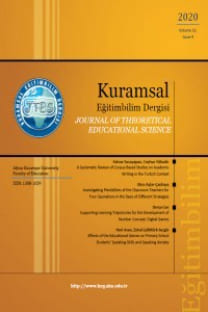Understanding of Geometric Reflection: John’s learning path for geometric reflection
geometric transformations, pre-service teachers, geometric reflection, motion view mapping view.,
___
- Arnon, I., Cottrill, J., Dubinsky, E., Oktac, A., Roa Fuentes, S., Trigueros, M., & Weller, K. (2014). APOS theory: A framework for research and curriculum development in mathematics education. New York, NY: Springer.
- Asiala, M., Brown, A., Devries, D., Dubinsky, E., Mathews, D., & Thomas, K. (1996). A framework for research and curriculum development in undergraduate mathematics education. In J. Kaput, A. Schoenfeld, & E. Dubinsky (Eds.), Research in Collegiate Mathematics Education II, CBMS Issues in Mathematics Education (Vol 2, pp. 1-32). American Mathematical Society, Providence, RI.
- Boulter, D., & Kirby, J. (1994). Identification of strategies used in solving transformational geometry problems. Journal of Educational Research, 87, 298–303.
- Boyd, C. J., Cummings, J., Malloy, C., Carter, J., & Flores, A. (2004). Geometry (Indian Edition). New York: McGraw-Hill/Glencoe. Clements, D. H., Battista, M. T., Sarama, J., & Swaminathan, S. (1997). Development of students’ spatial thinking in a unit on geometric motions and area. The Elementary School Journal, 98(2), 171–186.
- Clements, J. (2000). Analysis of clinical interviews: Foundations and model viability. In R. Lesh & A. Kelly (Eds.), Handbook of research design in mathematics and science education (pp. 547-589). Hillsdale, NJ: Erlbaum.
- Dubinsky, E. (1991). Reflective abstraction in advanced mathematical thinking. In D. Tall (Ed.), Advanced mathematical thinking (pp. 95-126). Boston, MA: Kluwer Academic Publishers.
- Dubinsky, E., Weller, K., Mcdonald, M. A., & Brown, A. (2005a). Some historical issues and paradoxes regarding the concept of infinity: An APOS-Based analysis: Part 1. Educational studies in mathematics, 58(3), 335-359.
- Edwards, L., & Zazkis, R. (1993). Transformation geometry: Naïve ideas and formal embodiments. Journal of Computers in Mathematics and Science Teaching, 12, 121–145.
- Edwards, L. (2003, February). The nature of mathematics as viewed from cognitive science. Paper presented at 3rd Congress of the European Society for Research in Mathematics, Bellaria, Italy.
- Flanagan, K. A. (2001). High school students’ understandings of geometric transformations in the context of a technological environment. (Doctoral Dissertation, The Pennsylvania State University, 2001). Dissertation Abstracts International: AAI3020450.
- Glass, B. J. (2001). Students’ reification of geometric transformations in the presence of multiple dynamically linked representations (Doctoral Dissertation, The University of Iowa, 2001). Dissertation Abstracts International, AAI3009596.
- Goldin, G. (2000). A scientific perspective on structures, task-based interviews in mathematics education research. In A. E. Kelly & R. Lesh (Eds.), Handbook of research design in mathematics and science education (pp. 517–545). New Jersey: Lawrence Erlbaum.
- Gülkılık, H., Uğurlu, H. H., & Yürük, N. (2015). Examining students' mathematical understanding of geometric transformations using the Pirie-Kieren Model. Educational Sciences: Theory & Practice, 15(6).
- Guven, B. (2012). Using dynamic geometry software to improve eight grade students' understanding of transformation geometry. Australasian Journal of Educational Technology, 28(2), 364-382.
- Harper, S. R. (2002). Enhancing elementary pre-service teachers’ knowledge of geometric transformations. (Doctoral Dissertation, University of Virginia, 2002). Dissertation Abstracts International: AAI3030678.
- Hollebrands, K. (2003). High school students’ understandings of geometric transformations in the context of a technological environment. Journal of Mathematical Behavior, 22, 55–72.
- Hollebrands, K. (2004). High school students’ intuitive understandings of geometric transformations. Mathematics Teacher, 97, 207–214.
- Jackiw, N. (2001). The Geometer’s Sketchpad (Version 4.0) [Computer software]. Emeryville, CA: Key Curriculum Press.
- Martin, G. E. (1982). Transformation geometry: An introduction to symmetry. New York: Springer-Verlag.
- Mhlolo, M. K., & Schafer, M. (2013). Consistencies far beyond chance: an analysis of learner preconceptions of reflective symmetry. South African Journal of Education, 33(2), 1-16.
- National Council of Teachers of Mathematics. (2000). Principles and standards for school mathematics. Reston, VA: NCTM.
- Núñez, R. E., Edwards, L. D., & Filipe Matos, J. (1999). Embodied cognition as grounding for situatedness and context in mathematics education. Educational studies in mathematics, 39(1), 45-65.
- Portnoy, N., Grundmeier, T., & Graham, K. J. (2006). Students’ understanding of mathematical objects in the context of transformational geometry: Implications for constructing and understanding proofs. Journal of Mathematical Behavior, 25, 196–207.
- Schultz, K. A., & Austin, J. D. (1983). Directional effects in transformation tasks. Journal for Research in Mathematics Education, 14(2), 95-101.
- Tall, D., & Vinner, S. (1981). Concept image and concept definition in mathematics with particular reference to limits and continuity. Educational studies in mathematics, 12(2), 151-169.
- Tossavainen, T., Suomalainen, H., & Mäkäläinen, T. (2017) Student teachers’ concept definitions of area and their understanding about two-dimensionality of area. International Journal of Mathematical Education in Science and Technology, 48:4, 520-532, DOI: 10.1080/0020739X.2016.1254298
- Yanik, H. B. (2006). Prospective elementary teachers’ growth in knowledge and understanding of rigid geometric transformations. (Doctoral Dissertation, Arizona State University, 2006). Dissertation Abstracts International: AAI3210254.
- Yanik, H. B., & Flores, A. (2009). Understanding rigid geometric transformations: Jeff's learning path for translation. The Journal of Mathematical Behavior, 28(1), 41-57.
- Yanik, H. B. (2011). Prospective middle school mathematics teachers’ preconceptions of geometric translations. Educational Studies in Mathematics, 78(2), 231-260.
- Yanik, H. B. (2013). Learning geometric translations in a dynamic geometry environment. Education & Science, 38(168).
- Yanik, H. B. (2014). Middle-school students’ concept images of geometric translations. The Journal of Mathematical Behavior, 36, 33-50.
- Zorin, B. (2011). Geometric transformations in middle school mathematics textbooks. University of South Florida.
- ISSN: 1308-1659
- Yayın Aralığı: 4
- Başlangıç: 2008
- Yayıncı: Afyon Kocatepe Üniversitesi Eğitim Fakültesi
Ölçme Değerlendirme Amaçlı Geliştirilecek Bir Web 2.0 Aracına Yönelik İhtiyaç Tespiti
Sibel ER NAS, Havva YAMAN, Şeyma TURAN, Zeynep TATLI
Sinan OKUR, Özlem ACAR BULUT, Seval ERDEN ÇINAR
Güçlendirici Liderlik ile Öğretmen İş Performansı Arasındaki İlişki: Örgütsel Bağlılığın Aracı Rolü
